Rosetta’s MIRO – the Microwave Instrument for the Rosetta Orbiter – has made nearly two billion science measurements at Comet 67P/C-G, and generated over 1.5 million spectra of gases in the comet’s coma. Principal Investigator Mark Hofstadter shares his team’s highlights of the mission, the challenges faced, and a hint of what’s still to come…
Being the first submillimeter instrument to fly in deep space, and having everything work are pretty high on our list of achievements! While we expected to be able to study the nucleus and coma gases with our instrument, and hoped to be able to see the dust particles, it was still a thrill to actually see the instrument doing what we thought it would. This comet puts out a lot of dust, and the dust particles are larger than predicted, so it was easier for MIRO to see the dust than we thought it would be, and we’ve been able to study it in more detail than anticipated.
But, just as for several of the instrument teams, the post-hibernation checkout gave us an initial unpleasant surprise. We were very cautious at first, and turned on one component of MIRO at a time, monitoring things in between to make sure everything was stable and working as expected. Early in the turn-on sequence, and near the end of a tracking pass, at JPL we saw that one of MIRO’s sensors reported that the spectrometer’s temperature shot up by 25 degrees for a few seconds, from about 20 to 45ºC. That could have been the sign of a short circuit temporarily heating things! Everything else looked normal to us, however, and the people in the control centre in Darmstadt said they saw nothing unusual. The original principal investigator of our instrument, Sam Gulkis, had just a few minutes to decide whether or not to command an immediate shut down of MIRO, before we lost radio contact with the spacecraft for several hours. What would you do? Shut down just in case something was short-circuiting to prevent further damage, or keep it on to avoid the risk of something having broken that would prevent us from turning it back on in the future? Sam, in Darmstadt, decided to leave MIRO on while we were out-of-contact. It was after midnight in Darmstadt when this happened, and Sam had been awake for many hours, so he went to sleep for a few hours while those of us at JPL (where it was still daytime) continued investigating. Sam later told us he fell asleep thinking we lost our instrument before even getting to the comet.
At JPL, one person asked the question “Why didn’t the control centre in Darmstadt, who monitor all the instruments, warn us that they saw a temperature spike?” Instead, Darmstadt reported everything looked normal! Strangely, he found that we did not ask Darmstadt to monitor the particular spectrometer temperature that spiked. At the same time, a second person contacted the lead engineer for MIRO and began describing the situation to her. She said that she recalled that one of the temperature sensors we had was unreliable, and even on the ground before launch would sometimes give crazy readings. Things began to make sense! We looked back through our documents, and found that the temperature sensor that spiked was the unreliable one. Because we knew it was unreliable when we launched it in 2004, we told ESOC not to monitor it. But by 2014 we had forgotten the problem, and at JPL we were looking at all our temperature sensors and saw the (false) spike.
When Sam woke up, we were able to tell him that he made the right choice in leaving MIRO turned on, and when Rosetta came back in contact with the Earth, we saw that MIRO was operating normally with all temperatures and currents as expected.
This story highlights one of the challenges of a long duration mission like Rosetta – how do you remember important details about your instrument which was built years ago? Most of the instruments on Rosetta were designed in the mid-1990’s, and started being built around 1997. We launched in 2004, and arrived at the comet in 2014. So now, near the end of 2016, we are using some hardware and software that is almost 20 years old. In many cases, the people who built it have retired. From the start, ESA realized that it was important to try and preserve as much human knowledge as possible in a format that would be easy to look up later. This included video documentation of the people building the instruments explaining anything that they thought could be relevant to the future, as well as typical user manuals and so-called design memos addressing very specific topics. MIRO’s user manual is about 300 pages long, and we are constantly updating it – we’re currently on version 5, and expect at least one more revision after the end of the mission!
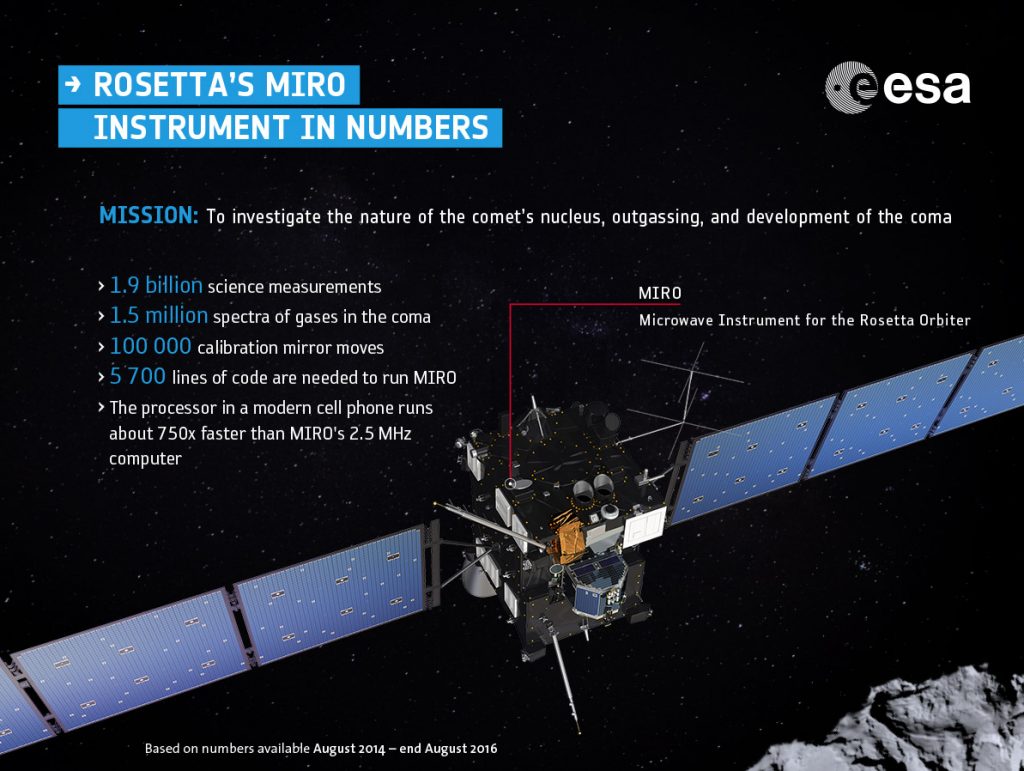
Mark adds that in addition to the above facts, there were also 7 children and 9 grandchildren born to members of the MIRO science team during Rosetta’s mission.
Difficult detections
We were surprised at how difficult it was for MIRO to detect the gas CO (carbon monoxide) around the comet. CO interacts strongly with radio waves, and we expected it to be seen soon after water was detected. Instead, it was the last molecule we saw of the six MIRO was designed to measure. Water was seen early in the summer of 2014, while it was only near perihelion – in the summer of 2015 – that we saw CO. The ROSINA instrument had measured CO in certain areas around the comet before that, but it was not everywhere. That seems to be why MIRO (and some of the other instruments) had so much trouble detecting CO. Early in the mission we were spending most of our time in the northern hemisphere, while the CO was mostly coming from the southern hemisphere.
One of the most difficult observations we made at the comet was measuring the polarized emission from the surface. Polarization describes how the electric and magnetic fields in a radio wave are oriented. MIRO measures one of the two possible orientations of the radio waves, which is typically sufficient; most of the radio waves given off by the comet are unpolarized (meaning they have random orientations), so the total amount of radio energy emitted by the comet is twice what we measure. But when radio waves encounter an abrupt change – such as when they strike the boundary between the nucleus and space – at a certain angle, one polarization can be preferred over the other. The angle at which that occurs (called the Brewster Angle) can be used to determine some of the electrical properties of the nucleus material. By the way, polarized sunglasses use this principle: sunlight reflected off a roadway or the sea for example, is preferentially polarized in one direction, and the sunglasses block that polarization, reducing the glare. You can test the effects of polarization yourself: next time you are wearing polarized sunglasses compare what you see holding your head normally with what you see tilted 90 degrees to the side (so your ear is almost touching your shoulder); some reflections and some digital displays will look much dimmer with your head tilted one way or another.
MIRO wanted to take advantage of this effect by observing the same spot on the nucleus at about the same time, but with the spacecraft in two different orientations (just like tilting your head). That would allow MIRO to measure both possible polarizations of the radio waves, and any preference for one polarization over the other would let us learn something about the properties of the nucleus we could not figure out any other way. That turned out to be very difficult to do for the following reasons:
– It can take more than an hour to rotate the spacecraft 90 degrees. During that time, the spot we are looking at on the nucleus is moving and the viewing geometry is changing, making it hard to interpret our measurements.
– Because Rosetta is solar powered, we never want to tilt it in such a way as to prevent our solar panels from getting sunlight. That limits when we could try to make this measurement.
– Rotating the spacecraft can interfere with some of the measurements being made by other instruments on the spacecraft.
– Other high priority science investigations could only be done at the times when it was easiest to do our polarization measurements.
In the end, after lots of hard work from the Science Ground Segment folks at ESAC, they determined a handful of times we could make these measurements. They were successfully carried out, but it will take us quite awhile to fully calibrate and measure this small polarization effect.
Surprises and mysteries
Being surprised by what we see at the comet is, of course, one of the most fun things about this mission! MIRO has seen that some properties of the comet’s nucleus (those related to how it warms and cools in response to sunlight) are relatively uniform all over the surface and down to a few centimetres beneath the surface. Many on our team expected these thermal properties to be much more variable. Other aspects of the nucleus, such as its composition, do seem to vary from place to place (such as the amount of CO, which I mentioned earlier). That is something we hoped to see, but were not sure whether or not it would be true. These are clues we are now using to try and figure out where and how comets form, and how they evolve over time.
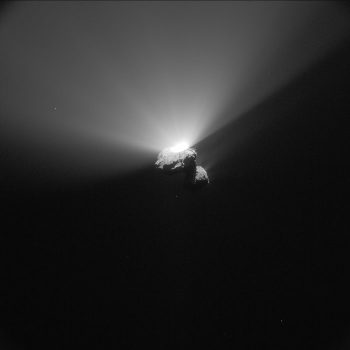
Comet outburst seen on 22 August 2015, during 67P/C-G’s most active perihelion period. Credit: ESA/Rosetta/NavCam – CC BY-SA IGO 3.0
For me, one of the most surprising measurements was that some comet outbursts seem to have lots of dust but little gas. How can that be, given that we thought the gas is what lifts the dust? When ice in the nucleus sublimates (turns to gas), it expands rapidly into the relatively empty space around the comet. The gas moves at hundreds to over a thousand metres per second. This rapidly moving gas is what is thought to move most of the small dust particles seen lifted off the nucleus. Rosetta has observed many comet outbursts. In some of them, pictures reveal narrow ‘jets’ of small dust particles. Our expectation is that these dust jets are marking spots where gas jets exist. We were surprised to see that some dust jets don’t seem to be associated with any extra gas emission, and similarly, we may have seen instances of gas jets existing without lifting any dust. Another mystery is that the MIRO instrument has seen the situation where a dust jet forms and the coma gases get 40ºC warmer, before the amount of gas increases (the 19 February 2016 outburst is the best studied example of this). What is going on?
The answer seems to be that Rosetta’s close-up view is letting us see the effects of complex interactions among the gas, dust and the surface of the nucleus. We are still analysing the data, but some of the ideas being explored involve landslides on the nucleus that moves the dust (this allows dust emission to increase without any change in gas emission), and warm dust heating the relatively cool coma gases (explaining why the temperature of the gas could change even when the amount of gas did not).
Water, water everywhere…
MIRO observes changes in comet activity over time: this plot shows some comparisons in MIRO’s measurements over the duration of the mission.
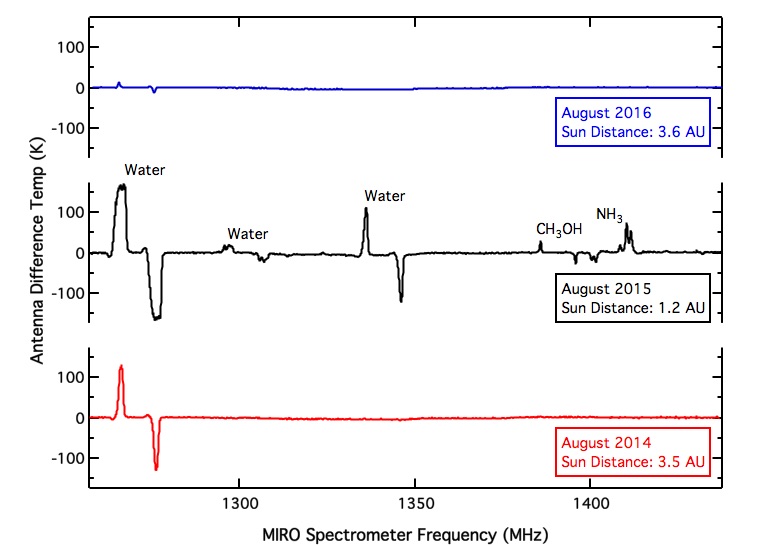
The bottom curve, in red, shows what MIRO measured in August 2014, when Rosetta first arrived at the comet and we were relatively far from the Sun (3.5 AU). The up and down spikes near the left edge of the plot are from water. By August 2015, when the comet was closest to the Sun (1.2 AU) and very warm, much larger amounts of water and other gases were detected (shown in the middle, black curve). The largest features are labeled with the molecule creating them: water (H2O), methanol (CH3OH), and ammonia (NH3). There are other species detectable whose signals are small and hard to see on this plot. By August 2016, the comet had moved away from the Sun again (3.6 AU) and cooled. The spectra at this time (blue curve at the top) shows only a small water line. In August 2016, the comet was emitting about 500x less water than it was in August of 2015. Graphic courtesy M. Hofstadter.
More science to come!
After the end of operations this month, we’re looking forward to analysing everything, both because we know we’re going to figure out all kinds of details when we have time to sit back and really think about our datasets, and because the most exciting things are probably going to be serendipitous discoveries! Recently MIRO has been studying how the nucleus properties change with depth in the upper tens-of-centimetres of the surface. Our simple models indicate there are changes, but we want to do more work to convince ourselves the effect is real. We’re also looking at how the presence of dust can influence gases far away from the dust, specifically what happens to the fast-moving gas as it moves through the much slower dust, and how heat emitted from the relatively warm dust might get absorbed by gas far away.
And finally…
Being part of this large, international team, doing something that is difficult and exciting, is a highlight of working this mission. On a personal note, it always gives me a feeling of pride in humanity to walk into one of our Rosetta science team meetings, and see how the individuals seamlessly transition among conversations internal to an instrument team to those across national or instrument boundaries. Languages and priorities may differ, but it is clear we are all working towards the success of the same mission.
This post is part of a series that looks behind the scenes of the instrument teams to find out what it was really like “living with a comet” for two years.
MIRO stories featured on this blog
Rosetta’s first peek at the comet’s south pole
MIRO maps water in comet’s coma
Comet ‘pouring’ more water into space
Getting to know Rosetta’s comet – Science special edition
MIRO bathes in water vapour

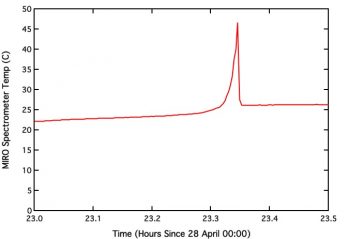
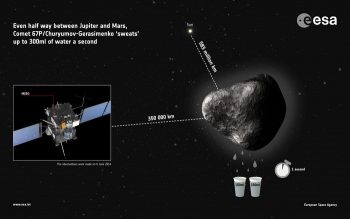








Discussion: no comments